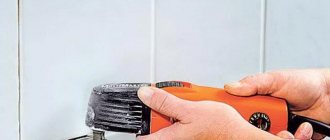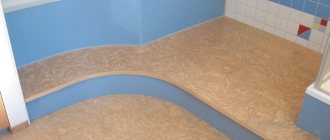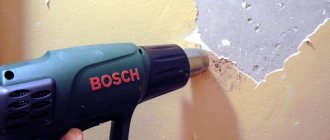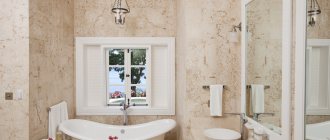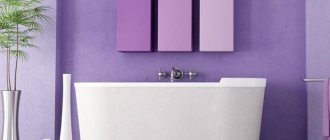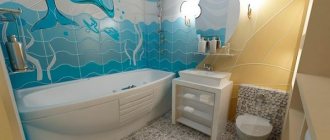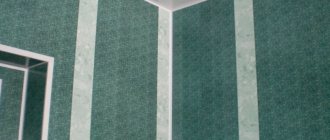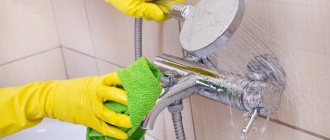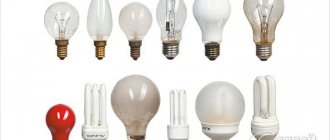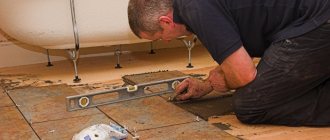Mold always appears in damp, poorly ventilated areas. The fungus also grows where there is little sunlight and high air temperatures.
The bathroom is an ideal breeding ground for mold. When cleaning this room, do not miss the first signs of fungal development.
Small black spots can be easily eliminated using modern household chemicals or using folk remedies. If mold occupies the bathroom thoroughly, then it will be much more difficult to fight it.
This article will tell you how to remove mold from the bathroom ceiling, how to clean the areas between the tiles on the wall, what products will help you quickly get rid of black fungus yourself, and how to use them correctly.
Why does mold appear in the bathroom?
The main factor responsible for the formation of dark plaque is high humidity. It is impossible to eliminate it only if you stop using this room altogether. Additional ventilation helps partially solve the problem. It is also recommended to wipe down the bathroom after every shower. However, this is not always enough, since there are always wet towels and so on hanging in this room.
Other causes of mold include:
- Lack of sunlight. As you know, ultraviolet light has disinfecting properties, so it actually destroys many harmful microorganisms. If there are no windows in the bathroom, then in conditions of high humidity, microbes and fungus grow many times faster.
- Improper finishing work. For example, some builders save on materials and do not treat walls with special antiseptics and waterproofing compounds. When working independently, people also often seal tile joints incorrectly or poorly.
- The room is heated too much. Moisture, lack of daylight and heat are the most favorable environment for microorganisms.
- Damage to the drainage system. If the faucet is constantly leaking in the bathroom, and a puddle forms under the bathtub, then after a while mold will appear.
As you can see, it is very difficult to completely exclude the possibility of the appearance of such microflora. Therefore, you need to periodically inspect the room and, at the first sign of black mold, begin removing it.
Where to look for mold and what to do
If there is a smell of mold, but upon a quick inspection it is not visible, it is worth walking with a flashlight to the favorite places where colonies occur.
- Dark corners near the floor, under the bathroom, behind hanging cabinets.
- Switches and sockets. This is especially true after a flood caused by neighbors above, or pipe breaks in the ceilings.
- Ventilation ducts. Idle city ventilation becomes a breeding ground for infection.
- Suspended ceilings. They retain water from leaks from the upper apartments. The owners may not even know that there is water above their heads, and meanwhile mold is happily multiplying in the darkness of the inter-ceiling space.
- Places behind cast iron and steel pipes. The metal accumulates condensation, constantly “wets” the wall, and becomes a source of mold.
- After discovering the aggressor, they begin to destroy him. To do this you need to prepare.
- Buy a protective gauze mask. It will cover the respiratory tract from mold spores during cleaning. After work, the mask is thrown away.
- Buy rubber gloves. After cleaning the mold outbreak, it is also better to get rid of them.
- Choose a means and method for eliminating mold.
We recommend reading: Greenery is good, just not on the floor - removing “diamond greenery” from linoleum
Chemicals should not be used by people with allergic reactions to household chemicals and during acute periods of respiratory diseases. For serious respiratory problems, it is better to use folk remedies.
Chemical and traditional remedies for mold in the bathroom differ in purpose, scope of application, and power of impact.
Cleaning tile joints
Before using anti-mold products, be sure to clean the surfaces as much as possible from plaque. The most difficult area is considered to be the seams between the panels. Therefore, first of all, they are mechanically cleaned using a stiff brush.
Important! During any mold removal work, you must protect your eyes, respiratory tract and hands. Therefore, it is necessary to purchase a respirator, gloves and goggles.
After brushing the seams, it is advisable to use a steam generator that supplies hot steam under high pressure to the surface. Thanks to this, it is possible to get rid of the deepest dirt, mold spores and lime deposits. If a steam generator is not available, then do not rush to use aggressive chemicals. First, you should try folk remedies.
Preventive measures
To prevent mold from settling in your home, it is necessary to take preventive measures in time:
- Ventilation of premises. A prerequisite for the presence of metal-plastic windows.
- Using a fan or air conditioner (with filters that do not allow mold to grow inside the air conditioner itself, otherwise the fungus will have to be removed not only from the walls).
- Thorough removal of moisture from tiled walls after water procedures (the use of a rubber windshield wiper, which is used by drivers, is effective).
- The curtain in the bathroom is a source of fungi. It should be dried in time.
- High-quality waterproofing will help protect the ceiling from unexpected flooding by neighbors above.
- Plumbing repairs completed on time.
- House plants and their quantity. You need to get rid of the extra ones.
Soda
Soda is a universal abrasive compound that costs a penny and is absolutely harmless to humans. In addition, baking soda perfectly absorbs moisture and “dries” the surface.
To treat surfaces, you can dilute baking soda in warm water (about ¼ tablespoon per 200 ml of water) and apply the liquid to the walls using a spray bottle. After this, the dirt is removed with a stiff brush or rough sponge.
Healthy! To increase the effectiveness of the product, you can add a little white bite to it.
If you need to clean the seams between the tiles, then it is better to prepare soda differently:
- Dilute baking soda with warm water to form a thick paste.
- Apply the resulting composition to the seams and rub in thoroughly with an unnecessary toothbrush.
- Leave the mixture for 1 hour so that the soda can penetrate deeper.
- We rinse the surfaces, brush again and thoroughly wash the seams again.
Why is fungus in the bathroom dangerous?
The habitat of mold mycelium is very diverse. This can be not only brick or concrete, but also various paint and varnish coatings. Sometimes the fungus is difficult to notice at all, because it can even develop under the tiles.
Actively developing, he can:
- destroy building materials, which can lead to possible collapse of the structure;
- worsen the aesthetic properties of the finish;
- pose a danger to human health.
Regarding the last point, the spores enter the respiratory organs, which can lead to the development of:
- asthma;
- allergies;
- other serious diseases (including joint damage).
It is for this reason that at the first signs of fungal development it is necessary to take urgent measures.
Fungus in the bathroom: a dangerous neighborhood
Vinegar
This natural remedy is very effective against more than 80% of all types of fungi. It contains acids that not only literally eat away dirt, but also help get rid of the unpleasant smell of mold. White vinegar can be found in any store. It is safe for health and also costs nothing. For minor surface contamination, just add a small amount of vinegar to warm water and rinse the walls, floor and ceiling of the bathroom.
For seams, it is better to use undiluted vinegar (don't forget to wear gloves), which is applied to a clean rag or sponge. After the mold has been removed as much as possible, apply a vinegar solution from a spray bottle to the cleaned surface and leave it until completely dry.
Household chemicals
Designed to quickly and effectively remove fungus, household chemicals can clean contaminated surfaces several times faster than any folk remedy.
If you are not allergic to the components of antifungal drugs and there are no pets in your apartment, then feel free to use special anti-mold chemicals.
"Belizna" - chlorine-based solution
The most famous and inexpensive product called “Whiteness” for 50 rubles. Excellent removes mold stains from various surfaces.
Spraying a bleach solution onto a whitewashed ceiling will remove mold stains and stop mold growth.
To prepare the solution:
- Bleach is diluted with water in a ratio of 1 to 10.
- Apply it to a cleaned surface and wait for it to dry.
The disadvantage of this product is the specific smell of chlorine.
Oxygen bleach
It is based on sodium percarbonate , which can cope with different types of mold.
This product is well suited for removing stains from colored surfaces. With its help, you can remove fungus from curtains in the bathroom, remove black stains from tile joints, curtains, etc.
There is a large selection of such bleaches on sale. The most famous:
- "Bos Plus" costs about 30 rubles;
- “Sano Oxygen”, it can be bought for 280-300 rubles;
- “Vanish Gold” for 140-150 rubles.
Special antifungal
Such products are distinguished by their speed of action and effectiveness . With its help you can easily tidy up:
tiles;- plumbing;
- shower cabin.
Cleaning surfaces will take from 10 minutes to an hour . The most popular products today are:
- “Cillit Bang”, price 150-170 rubles;
- spray “Unicum”, costing about 180 rubles;
- “Turbo”, priced at 300-350 rubles.
Hydrogen peroxide
Chlorine is often used to combat mold. But it is extremely aggressive and has a very pungent and unpleasant odor. Therefore, before using chlorine, it is worth trying its alternative - hydrogen peroxide, which is safe for health, odorless and cannot damage the surface. In addition, everyone is well aware of the antibacterial and antimicrobial properties of hydrogen peroxide. It is suitable not only for treating walls, tiles and floors, but can also be used for equipment and even clothes that have been affected by fungus.
Important! Peroxide has a weak bleaching effect, so it is not recommended for colored or dark-colored items.
To process seams between panels:
- Apply a 3% peroxide solution to the grout.
- We wait until it is completely absorbed and dries.
- Remove dirt using a stiff brush.
- We thoroughly wash the seams.
- Apply a weak solution of hydrogen peroxide to the surface using a spray bottle.
Professional antiseptics
The best results in the fight against mold can be achieved by using branded antiseptic preparations. You can buy them at construction stores. Below are several popular formulations for removing fungus:
- Antiseptic drug "Antifungal" from. This antiseptic can be used both as a preventive measure and in case of mold outbreaks. The Antifungal solution is applied with a brush or roller to a wide variety of surfaces, including concrete, brick, wood, and plaster. As a preventative measure, Antifungal is added to wallpaper glue or paint materials. In this case, the concentration of the antiseptic should not exceed 1% of the total volume. The drug is environmentally friendly and non-toxic. “Antifungal” is sold in plastic bottles holding 1 or 10 liters of the composition.
- produces antiseptics under the Izotsid brand. The drug is used to prevent mold on tiles, wood, concrete, plaster, brick and stone. In addition to mold, Izocid successfully fights microscopic algae, blue stains and other microorganisms unsafe for human health. “Isocide” goes well with water-soluble paints and varnishes. The drug can be used at different stages of repair work, adding it to paints, cement mortar, and chalk mixtures.
- launched the production of latex-based emulsion under the MILLKILL trademark. The emulsion prevents the formation of mold fungi due to the antimicrobial agent it contains. The emulsion shows the greatest effect when treating walls with small pores. "MILLKILL" is safe for health and therefore can be used in any residential area. Before applying the product, it is recommended to remove traces of mold using a hard bristle brush.
- Antiseptic "DALI" belongs to the class of universal drugs, since it can be used both as a preventive measure and to remove existing fungus. The drug is a colorless solution - environmentally friendly and non-toxic. The versatility of DALI is also evident in its effectiveness in the fight against wood insect pests. Available in 5-liter containers. Per square meter of surface you will need 250 milliliters of the drug (for preventive purposes, 100 milliliters for the same area is enough).
Note! Mechanical mold removal will not bring the desired result if it is not supported by chemical surface treatment.
Before using an antiseptic, it is recommended to test its compatibility with finishing materials.
Important! Antiseptic treatment is carried out only under the condition of protecting the skin (rubber gloves) and the respiratory tract (respirator).
Boric acid and borax
This is another affordable product that can be purchased inexpensively at any pharmacy. Boric acid is an excellent antiseptic that successfully fights mold. To use the product:
- Mix 1 part boric acid with 2 parts vinegar and hydrogen peroxide. Add 4 parts of clean water to the mixture.
- Heat the mixture slightly (you can use a water bath).
- Apply the mixture to the seams and leave to soak for 40 minutes.
- We rinse the surfaces with water and get rid of mold residues.
You can also use borax, which is a derivative (sodium salt) of boric acid. Borax has the same benefits. It is also often used to control pests (fleas, ticks) and rust.
When it comes to cleaning mold, it is better to use borax in powder form:
- Dilute a glass of dry borax in a bucket of clean water.
- We apply the liquid to the walls, floors and tile joints.
- We wait 10 minutes and rinse everything thoroughly with water.
Homemade recipes for eliminating fungal plaque in the bathroom
Fungus in the bathroom usually appears first in the corners: on the floor or ceiling. The spores of these microorganisms quickly spread throughout the room, so very little time passes from the first manifestations of the proliferation of pathogenic bacteria to the appearance of extensive spots of black mold on various surfaces.
eliminating fungus in the bathroom
As soon as a small black spot appears on the ceiling, plumbing, pipes or tiles, you must immediately take all measures to combat this unpleasant phenomenon. In the initial stages of mold development, you can do this yourself, using folk remedies that are available to every family, for example, soda and vinegar. Fungal cells are destroyed by these substances, and the growth of the entire colony of microorganisms stops.
It’s very simple to prepare a special product and remove black mold from the bathroom:
- All surfaces in the room must be treated with soda and then extinguished with vinegar. Particular attention should be paid to those areas where the fungus is actively growing. But even a mold-free surface is best coated with an even layer of baking soda and vinegar paste to prevent the spread of fungus.
- After 1 hour, the soda should be thoroughly rinsed with warm water and bathroom detergent.
- The room must be thoroughly dried after treatment.
An equally cheap way to clean walls from fungus is boric acid and hydrogen peroxide. The components are mixed in equal parts with water, after which all surfaces in the bathroom are wiped with the liquid. However, it should be remembered that hydrogen peroxide can damage paint, especially on wood or plastic, so such products should be used with caution. After treatment, the walls must be washed with running warm water.
There is a folk remedy for black mold that does not need to be washed off, as it is completely harmless to humans. This is tea tree oil. The substances contained in it have a detrimental effect on fungal cells. It is enough to stir 2 tsp. tea tree oil in 2 glasses of water and spray the resulting mixture onto the walls using a spray bottle. It is advisable not to use the bathroom for several hours after treatment (you can use an antifungal agent in the evening before bed).
Tea tree oil
It is not only effective and has antimicrobial properties, but also has a positive effect on humans. Essential oil is a little more expensive, but it fights mold well. If it has not grown much, then:
- Dilute 2 teaspoons of oil in two glasses of water.
- Apply the aromatic mixture to tile joints and other surfaces.
- We wait until it dries completely and ventilate the bathroom.
If mold has been growing for a long time, then you need to fight it with more aggressive means.
Causes of fungus
As was said at the beginning of the article, the main condition for the development of fungus is a high level of humidity, and not just high, but exceeding 70-80%. The ideal microclimate for the occurrence of fungus occurs at a humidity level of 90-95%. Insufficient ventilation in the bathroom also plays a significant role in the formation of mold.
The next factor favoring mold fungus is insufficient waterproofing of the room. If the bathroom is often hot (more than 20 degrees Celsius), the appearance of fungus is only a matter of time.
When suitable conditions arise, spores, connecting with a moist surface, begin to grow rapidly, creating colonies. If nothing is done, small black, green or brown spots of mold gradually grow and occupy larger and larger areas. In this case, the spores not only grow in width, but also penetrate into the material with thin threads.
Fungus can affect both the walls and floor of the bathroom. Typically, mold forms primarily on the seams between tiles.
Ammonia
Ammonia is effective against mold, but it does not have the best effect on humans. Therefore, work is usually carried out in a well-ventilated area, which is almost impossible in the bathroom. At a minimum, you need to use a respirator and safety glasses. Otherwise, you may experience a severe headache and even nausea.
For processing:
- Mix a glass of clean water with a teaspoon of ammonia. Additionally, you can add 10 drops of essential oil.
- Apply the solution to the tile joints and leave for half an hour.
- Rinse with water (preferably several times).
Important! Do not, under any circumstances, experiment with mixing ammonia with bleach. This is a chemical reaction that will release a very dangerous toxic gas.
Folk remedies against mold
Opponents of the use of aggressive chemicals to destroy black fungus often use improvised means. Many of them give good results.
Remedy #1 - baking soda in tandem with vinegar
Black mold recedes in front of such a simple remedy as soda ash - soda ash or regular in tandem with vinegar.
It’s easy to prepare the mixture:
- take 5 liters of water, but only hot;
- throw 150 g of soda ash or 150 g of regular soda into it;
- to this add 9% vinegar - 100 g.
Having received a foamy liquid, problem surfaces are treated with it. On a horizontal surface, you can remove blackness more easily. Strongly overgrown mycelium is removed with a spatula, and then these areas are sprinkled with soda. Next, put a spray bottle on the bottle with vinegar and spray the surface to extinguish the soda.
A mixture of soda and vinegar works well against mold that has settled in the seams of facing tiles. After 20 minutes of action of the mixture, it is washed off with a brush.
The mycelium dies during the process of foaming, indicating that sodium bicarbonate has reacted with acetic acid.
If there is a washing machine in the bathroom, mold can grow there too. Often black marks can be seen on the sealing rubber, but it is much worse when it penetrates inside the tank. You can remove it from there using vinegar and “Whiteness”.
To do this, these two components are mixed in equal proportions. The powder compartment is soaked in this solution for half an hour. Afterwards, clean it with a brush.
The solution is poured into the machine and, having set it to the longest mode, the highest temperature, it is turned on. Under the influence of high temperature and active substances, microorganisms will die.
We looked at other ways to get rid of mold in a washing machine in the following material.
Remedy #2 – tea tree oil
This non-standard method gives a good result, because... mold microorganisms are sensitive to the components that make up this aromatic oil.
The usage scheme is as follows:
- Buy a bottle of tea tree oil.
- Hands need to be protected, so rubber gloves are also needed.
- Take a spray bottle and pour water into it.
Add 2 large spoons of aroma oil to 500 ml of water. Stir the mixture, pour it into the bottle, and shake. After this, the product can be used for processing.
After application, the mixture does not need to be washed off; it should work. Since the product is natural, it is safe for both people and pets.
It is sprayed on the affected surface, then the fungus is collected with a cloth. To enhance the result, it is advisable to repeat the procedure and leave the treated area to dry naturally.
If the walls in the bathroom are severely damaged, you need a more concentrated solution - 20 ml of oil per 1000 ml of water. It is best to do the treatment using a brush with a long handle.
Since the product has a specific odor, it does not dissipate quickly. To protect your walls from possible damage from black mold in the future, you can add a little oil to the paint. This will stop the development of the colony if mold penetrates thoroughly into the thickness of the wall.
Remedy #3 - Hydrogen Peroxide
This tool is available and inexpensive. There is no need to do any manipulations with it. It is simply poured into a container with a spray bottle and sprayed undiluted. After 15 minutes of exposure, the treated areas are wiped.
Not every surface can be treated with a preparation such as 3% hydrogen peroxide, since it tends to bleach some materials. To be on the safe side, you need to test its effect in a small area.
With the same success, perhydrol can be replaced with furatsilin or copper sulfate.
Remedy #4 - boric acid
Borax, borax or boric acid is the name of one drug. Half a glass of the substance is diluted in a liter of water. The tile seams and other places where mold is found are cleaned with a stiff brush dipped in a solution. After some time, wipe the treated areas with a dry cloth.
There is one unpleasant moment in this process - the substance is not entirely safe, because it irritates the respiratory tract. Therefore, gloves and a mask must be mandatory when processing borax.
It is also advisable to perform work in the absence of children and pets.
Remedy #5 - aqueous ammonia
Non-porous surfaces in the bathroom are well cleaned and disinfected with ammonia. Ammonia is simply applied to the surface using a sponge or cloth. The effect is increased by adding glycerin in small quantities.
The downside is toxicity. Because of this, it can cause irritation of the mucous membranes and even poisoning.
The mixture is left on the surface for one hour, then washed off with water. When using ammonia, you need to know that it evaporates by 50% of the original volume and does not always have time to react.
Like boric acid, ammonia emits a very strong and pungent odor. This may cause irritation.
Remedy #6 - Chlorine Bleach
This simple remedy poses a threat not only to indoor mold, but also to outdoor mold.
The active component of “Belizna” is the inorganic compound sodium hydrochloride. It has disinfectant and antiseptic properties. The working substance in the bleach is 3 – 6%
The percentage of chlorine in “Belizna” is very high, hence the good disinfecting effect. Among all the available means considered, bleach is the leader. It is also good for removing mildew from boards (various wooden surfaces).
The downside is toxicity. Because of this, it can cause irritation of the mucous membranes and even poisoning.
Remedy #7 - copper sulfate
This product kills mold from tiles, primers, and plastic. It needs to be diluted with water. The proportion is 100 g of substance per 10 liters of liquid. The solution is applied to the surface with a brush; it is better to do this in several layers. For prevention, a product is also applied around the area with mold.
Everything is left in this state for some time. Next, you should wash the treated areas and ventilate the room. The product is toxic, so you will need a respirator and gloves to work with it.
Bleach
Of all the folk remedies, chlorine-containing solutions are recommended to be used only when nothing else has helped. It is also worth considering that chlorine can only be used on concrete, tile, glass and other durable surfaces. But it is not suitable for drywall and wood (as well as for any materials with a porous structure).
To treat seams and other areas of the bathroom, you can use the cheapest bleach (for example, “Whiteness”). It must be diluted in water in a ratio of 1:10. The finished mixture is applied using a sponge or spray until completely dry. To prevent the re-formation of mold, after cleaning you should not rinse the surfaces with water, but be sure to ventilate the room.
Prevention measures
Fighting fungus in the bathroom is much more difficult than preventing it. To keep your bathroom mold-free, follow these tips:
- Monitor the humidity in the room.
Inspect the condition of the pipes and plumbing to ensure there are no leaks. Pipes on which condensation appears must be insulated using an insulating tube or other material designed for this purpose. The air can be made drier by hanging a large heated towel rail in the bathroom or installing heated floors. - Provide good ventilation. Check how the hood works.
- Make sure that no cracks appear on the walls and ceiling.
Copper sulfate
It can also be found in stores under the name copper sulfate. Gardeners and builders love to use this product, as it is effective against pests and fungi. But it is important to note that copper sulfate is extremely toxic, so you need to protect your eyes, skin and respiratory organs.
For processing:
- Dissolve copper sulfate in water in a ratio of 1:10.
- Using a soft brush, carefully apply the mixture to the seams.
- Let it soak in for 2-3 hours.
- Wash and dry the surfaces thoroughly.
But even the most powerful folk remedies do not always help to completely get rid of mold. In this case, you will have to purchase more expensive specialized compounds.
Microwave drying of walls from mold
Mold is afraid of dryness and high temperatures, so one of the most effective methods of surface treatment is microwave. It is effective against various types of fungus, including black mold, house fungus, wood fungus, and rot. The advantages of microwave treatment against mold include:
- any surface can be treated;
- safety in use;
- no chemical pre-treatment required;
- you can process floors through surfaces (for example, through parquet);
- little time spent on disinfection of any area.
Microwave treatment involves exposure to a surface of 50x50 with laser pyrometers. The installation heats up to 70 degrees Celsius, allows you to heat the material to a depth of 25-35 centimeters and destroy mycelium of any size. One treatment is enough to get rid of fungus in the house forever. The price for removing mold in a bathroom in Moscow is determined depending on the area affected by the fungus, the depth of penetration of the spores and the necessary preparatory procedures.
Specialized means
There are a huge variety of antifungal drugs. To quickly navigate this diversity, it is worth considering those compositions that are used most often:
- Atlas Mykos. This is a universal concentrated product that is effective against all types of organic plaque (this means that you can get rid of not only mold, but also moss and much more). Suitable for internal and external processing. Diluted with water in a ratio of 1:2. Costs about 400 rubles.
- Izohan Grzybostop. Can be used on concrete as well as lime surfaces. Effective against all types of fungus. It is equally effective both after the appearance of mold and during preventive treatments. The composition costs approximately 850 rubles per bottle with a sprayer.
- Snezka and Fungicide Concentrate. In the first case, we are talking about specialized paint with the addition of silver particles. After cleaning the mold, you need to apply this product, which will completely destroy all bacteria. The next step is to use a Fungicide. The paint will cost about 250 rubles per liter, and the second composition will cost about 500 rubles. But such processing is not suitable for wooden elements.
- Baroman. This is another concentrated remedy against fungi and organic plaque. On the contrary, it is mainly used for wood; it interacts especially well with pine. But if you happen to have it on hand, you can also use the drug to treat plastic seams. If the lesions are very serious, then treatment is carried out several times. This product costs approximately 1,000 rubles per canister of concentrate.
Of course, treatment alone, even with the most potent agent, will not be enough.
To prevent mold from appearing again, you should stop drying wet things in the bathroom, arrange ventilation, ventilate the room and try to carry out preventive treatments with at least vinegar or soda. Related publications:
Industrial products to combat fungus
In specialized stores you can find various drugs to combat household fungus in the bathroom:
- “Antifungal” is a special solution that has a broad fungicidal effect. The components of this liquid mixture are active against mold, mildew, mosses, lichens and some types of bugs that can grow in the apartment. The product is suitable for treating any surfaces except metal and propylene. Antifungal can be added to water-based paints, plaster, grout, and can also be used independently for surface treatment.
- “S-Hydrotex-P” is a domestic dry mixture that can be placed in any room: from the bathroom and kitchen to living rooms. The mixture is applied to reinforced concrete structures, which allows you to effectively combat not only the consequences of black mold, but also destroy its foci.
- “Natura Antimantar” is a special water-based primer for walls and ceilings. It is applied in a thin layer to the affected surface and completely destroys the fungus. After drying, the primer forms a protective film that prevents mold from reappearing. An additional advantage of this product is that it does not have a specific odor.
- “Biolavatio” - used in rooms with a lot of mold and mildew. It not only destroys harmful microorganisms, but also whitens surfaces darkened by mold.
- Homeenpoiste is a chlorine-based antifungal agent. Fights fungal spores on any surfaces, including wood and plastic.
- "HG" is an antiseptic that is produced in the Netherlands. Effective for destroying fungal infections in rooms with high humidity. Can be used to treat ceramic tiles, tile joints, walls and ceilings in the bathroom. "
- "Renogal" is a German sanitizing solution that fights not only fungus, but also other pathogenic microorganisms that can settle on various surfaces in residential areas.
When using industrial antifungal products, you must strictly follow the instructions for use and observe safety precautions so that strong chemical components do not damage the skin of your hands, and vapors of toxic substances do not enter the respiratory tract.
Fungus on wooden surfaces
The most difficult thing to remove is fungus that has grown on wood surfaces. And if you notice cotton-like formations, remove them immediately and treat the areas with a special solution. If the wooden parts are badly damaged, replace them.
Fungus on wood - photo
A 3% solution of potassium fluoride is quite effective. You can dilute it in water (20 g per 1 liter), mix thoroughly and apply the resulting product to the affected areas.
Causes of mold and how to get rid of dampness in the bathroom
Anyone who has encountered a fungus problem in their life has repeatedly wondered how to remove it in such a way as to prevent its recurrence.
Fertile soil for fungal growth is a warm and humid environment, so timely preventive measures will deprive mold of comfortable living conditions.
| Factors that cause fungal growth | Way to solve the problem |
| Insufficient ventilation in the bathroom. | Installing a hood or powerful fan. Using the forced ventilation method (the bathroom door should always be slightly open). |
| Faulty plumbing and leaking pipes. | Replacement or repair of old plumbing, eliminating leaks, replacing pipes. |
| Increased air humidity due to wet towels and drying laundry. | Installation of a high-quality heated towel rail. Installation of a "warm floor" system. Using another room for drying clothes. |
| Formation of condensation on cast iron pipes. | Replacing cast iron pipes with plastic ones. Thermal insulation with foam materials. |
| Excessive dampness of the walls caused by the corner location of the bathroom. | Installing a dehumidifier in the bathroom. |
| Poor waterproofing of surfaces in damp rooms. | The use of moisture-resistant paint on surfaces in the bathroom, preventing moisture from penetrating into furniture and finishing materials. |
In Soviet-era houses, constant ventilation in apartments was previously achieved naturally through gaps in window frames and cracks in entrance doors. The use of modern plastic windows and sealed doors deprived the premises of free ventilation, as a result of which the overall humidity in the apartments increased, which was the impetus for the extensive growth of fungus.
People began to look for solutions to the problem without noticing the root cause of its occurrence. This leads to the installation of an artificial ventilation system.
If such a system is unavailable for some reason, you should frequently ventilate the room and prevent condensation from forming on the windows in the apartment.
Fungus on tiles
A lot here depends on how far the mold has spread.
If it is present only on the surface, then:
- dissolve any product in water;
- take a sponge and wash off the fungus.
In case of greater penetration of microspores (for example, they are located between the tiles), take more serious measures.
Step 1. Using a putty knife, remove the grout.
Step 2. Dry the surfaces with a hairdryer.
Step 3. Treat the joints twice with an antiseptic.
Step 4. Grout the seams with new grout, adding an antiseptic.
Antifungal grout "Kesto" with antiseptics
Epoxy grout for joints Litokol Starlike Litoc
If the fungus has settled under the tiles, then only radical measures will help. You can also invite specialists who, knowing how to determine the strain of the fungus, will help with the selection of the most effective remedy.
Additional measures and rules when combating mold
Note! Another effective method in the fight against fungus between tiles is the use of a blowtorch or quartz lamp. Read how to install a bathtub correctly on the website.

